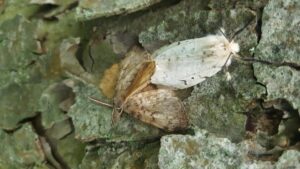 Introduction
Introduction
SBI 3U: Diversity of Living Things: Life cycles, Resistance of Insects to Pesticides
SNC 3C: Environmental Science: Population Growth, Local Use of Pesticides
SBI 4U: Population Dynamics: Predation, Parasites, Population Growth
Background: In mid July, gypsy moths emerge from their pupal stage and the males can be seen flying around in the daytime. The small grey/brown male moths are erratic flyers, in search of females. The females are larger white moths. The females do not fly well and can be found on the trunks of host trees. These adults can easily be caught, placed in specimen containers, and placed in a freezer. Some pupae will still be intact as the moths failed to emerge. Egg masses should be collected still attached to a substrate (tree bark). The date and location that the specimens were collected should be recorded.
Identification: Students are given a lesson on morphology of moths. This will describe the basic body design of moths. Students will complete an unlabelled diagram to show forewing, antenna, compound eye, proboscis, leg, abdomen, hindwing, and tail. Adult moth specimens will be handed out, and students will fully describe their appearance.
Click this link to get Dave’s complete article
Thanks for sharing Dave!!!!!!!!!

 Introduction
Introduction